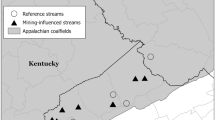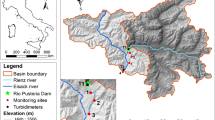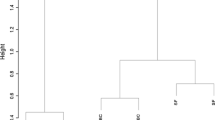Abstract
Survival and growth of Asian clamsmay be more sensitive endpoints than benthicmacroinvertebrate community richness parametersat distinguishing biotic impairmentattributable to complex effluents fromcoal-burning utilities. We conducted (1) fieldbioassays with the Asian clam (Corbiculafluminea) during 2000–02 and (2) rapidbioassessments of benthic macroinvertebratecommunities during 2000–01 at sitesupstream/downstream of American ElectricPower's (AEP) Clinch River Plant (CRP) inRussell County, Virginia (U.S.A). Survival andgrowth of transplanted C. fluminea weresignificantly impaired within the CRP effluentplume (averages of 35% and 0.21 mm,respectively) relative to all other study siteswithin the Clinch River (averages of 89% and1.58 mm). Conversely, richness metrics forEphemeroptera,Ephemeroptera-Plecoptera-Trichoptera (EPT), andtotal taxa were not reduced downstream of theCRP. However, relative abundance metrics forEphemeroptera and EPT were minimally reduced atthe CRP-influenced site during 2000–01. Moreimportantly, our results suggest that richnessmetrics for benthic macroinvertebratecommunities may be inadequate for assessing theeffects of complex industrial effluents on C. fluminea. These findings have implicationsfor bioassessment techniques employed tomonitor streams inhabited by imperiledfreshwater mussels because (1) C. flumineaand Unionoidea are ecologicallysimilar and (2) recent findings suggest certaingenera of Unionidae may be more sensitive thanC. fluminea.
Similar content being viewed by others
References
Adams, T. G., G. J. Atchison & R. J. Vetter, 1981. The use of the three ridge clam (Amblema perplicata) to monitor trace metal contamination. Hydrobiologia 83: 67-72.
Ahlstedt, S. A., 1984. Twentieth century changes in the freshwater mussel fauna of the Clinch River (Tennessee and Virginia). Master's Thesis, The University of Tennessee, Knoxville, TN.
Ahlstedt, S. A. & J. D. Tuberville, 1997. Quantitative reassessment of the freshwater mussel fauna in the Clinch and Powell Rivers, Tennessee and Virginia. In: Cummings, K. S., A. C. Buchanan, C. A. Mayer & T. J. Naimo (eds), Conservation and Management of Freshwater Mussels II: Initiatives for the Future. Proceedings of a UMRCC Symposium, 16-18 October 1995, St. Louis Missouri. Upper Mississippi River Conservation Committee, Rock Island, Illinois: 72-97.
Aldridge, D. W., B. S. Payne & A. C. Miller, 1987. The effects of intermittent exposure to suspended solids and turbulence on three species of freshwater mussels. Environ. Pollut. 45: 17-28.
American Public Health Association (APHA), American Water Works Association, Water Environment Federation, 1998. Standard Methods for the Examination of Water and Wastewater, 20th ed. American Public Health Association, Washington, D.C.
American Society for Testing and Materials (ASTM) E 2122, 2001. Standard Guide for Conducting In-situ Field Bioassays with Marine, Estuarine, and Freshwater Bivalves. American Society for Testing and Materials, Conshocken, Pennsylvania.
Armitage, P. D., 1980. The effects of mine drainage and organic enrichment on benthos in the River Nent system, Northern Pennines. Hydrobiologia 74: 119-128.
Barbour, M. T., J. L. Plafkin, B. P. Bradley, C. G. Graves & R. W. Wisseman, 1992. Evaluation of EPA's rapid bioassessment benthic metrics: metric redundancy and variability among reference stream sites. Environ. Toxicol. Chem. 11: 437-449.
Barbour, M. T., J. Gerritsen, D. S. Blaine & J. B. Stribling, 1999. Rapid bioassessment protocols for use in streams and wadeable rivers: periphyton, benthic macroinvertebrates and fish. 2nd ed., U.S. Environ. Protect. Agency, EPA-841/B-99-002.
Belanger, S. E., J. L. Farris, D. S. Cherry & J. Cairns, Jr., 1986. Growth of Asiatic clams (Corbicula sp.) during and after long-term zinc exposure in field-located and laboratory artificial streams. Arch. Environ. Contam. Toxicol. 15: 427-434.
Byrne, R. A. & T. H. Dietz, 1997. Ion transport and acid-base balance in freshwater bivalves. J. Exp. Biol. 200: 457-465.
Cairns, J., Jr., J. S. Crossman, K. L. Dickson & E. E. Herricks, 1971. The recovery of damaged streams. Assoc. Southeast. Biol. Bull. 18: 79-106.
Carlisle, D. M. & W. H. Clements, 1999. Sensitivity and variability of metrics used in biological assessments of running waters. Environ. Toxicol. Chem. 18: 285-291.
Chaplin, S. J., R. Gerrard, H. Watson, L. L. Master & S. R. Flack, 2000. The geography of imperilment: targeting conservation toward critical biodiversity areas. In: Stein, B. A., L. S. Kutner & J. S. Adams (eds), Precious Heritage: The Status of Biodiversity in the United States. Oxford University Press, New York.
Cherry, D. S., J. H. Van Hassel, J. L. Farris, D. J. Soucek & R. J. Neves, 2002. Site-specific derivation of the acute copper criteria for the Clinch River, Virginia. Hum. Ecol. Risk. Assess. 8: 591-601.
Clements, W. H., D. S. Cherry & J. Cairns, Jr., 1988. Impact of heavy metals on insect communities in streams: a comparison of observational and experimental results. Can. J. Fish. Aquat. Sci. 45: 2017-2025.
Clements, W. H., D. S. Cherry & J. Cairns, Jr., 1990. Macroinvertebrate community responses to copper in laboratory and field experimental streams. Environ. Contam. Toxicol. 19: 361-365.
Clements, W. H., 2000. Integrating effects of contaminants across levels of biological organization: an overview. J. Aquat. Ecosyst. Stress Recovery. 7: 113-116.
Diamond, J. M., W. Bower & D. Gruber, 1993. Use of man-made impoundment in mitigating acid mine drainage in the North Branch Potomac River. Environ. Manage. 17: 225-238.
Dickson, K. L. & J. H. Rodgers, Jr., 1986. Assessing the hazards of effluents in the aquatic environment. In: Bergman, H. L., R. A. Kimerle & A. W. Maki (eds), Environmental Hazard Assessment of Effluents. Pergammon Press, Elmsford, New York: 209-215.
Doherty, F. G., 1990. The Asiatic clam, Corbicula spp., as a biological monitor in freshwater environments. Environ. Monit. Assess. 15: 143-181.
Doherty, F. G. & D. S. Cherry, 1988. Tolerance of the Asiatic clam Corbicula spp. to lethal levels of toxic stressors-a review. Environ. Pollut. 51: 269-313.
Farris, J. L., J. H. Van Hassel, S. E. Belanger, D. S. Cherry & J. Cairns, Jr., 1988. Application of cellulolytic activity of Asiatic clams (Corbicula sp.) to in-stream monitoring of power plant effluents. Environ. Toxicol. Chem. 7: 701-703.
Fetterolf, C. M., Jr., R. M. Atlas, D. M. DiForo, S. E. Herbes, J. A. Leenheer, J. F. Paul, A. Spacie & T. Stuart, 1986. Discussion synopsis: Exposure assessment for effluents. In: Bergman, H. L., R. A. Kimerle & A. W. Maki (eds), Environmental Hazard Assessment of Effluents. Pergammon Press, Elmsford, New York: 191-205.
Foe, C. G. & A. W. Knight, 1987. Assessment of the biological impact of point source discharges employing Asiatic clams. Arch. Environ. Contam. Toxicol. 16: 39-51.
Fraysse, B., J.-P. Baudin, J. Garnier-Laplace, A. Boudou, F. Ribeyre & C. Adam, 2000. Cadmium uptake by Corbicula fluminea and Dreissena polymorpha: effects of pH and temperature. Bull. Environ. Contam. Toxicol. 65: 638-645.
García-Criado, F., A. Tomé, F. J. Vega & C. Antolín, 1999. Performance of some diversity and biotic indices in rivers affected by coal mining in northwestern Spain. Hydrobiologia 394: 209-217.
Goudreau, S. E., R. J. Neves & R. J. Sheehan, 1993. Effects of wastewater treatment plant effluents on freshwater mollusks in the upper Clinch River, Virginia, USA. Hydrobiologia 252: 211-230.
Graney, R. L., Jr., D. S. Cherry & J. Cairns, Jr., 1983. Heavy metal indicator potential of the Asiatic clam (Corbicula fluminea) in artificial stream systems. Hydrobiologia 102: 81-88.
Hickey, C. W. & W. H. Clements, 1998. Effects of heavy metals on benthic macroinvertebrate communities in New Zealand streams. Environ. Toxicol. Chem. 11: 2338-2346.
Hughes, B. D., 1978. The influence of factors other than pollution on the value of Shannon's diversity index for benthic macro-invertebrates in streams. Water Res. 12: 359-364.
Hull, M. S., D. S. Cherry & T. C. Merricks, in review. Growth of transplanted Asian clams varies with cage design in freshwater streams: implications to quantifying sub-lethal bivalve responses in situ.
Jhingran, V. G., S. H. Ahmad & A. K. Singh, 1989. Application of Shannon-Wiener index as a measure of pollution of river Ganga at Patna, Bihar, India. Curr. Sci. 58: 717-720.
Lenat, D. R., 1988. Water quality assessment of streams using a qualitative collection method for benthic macroinvertebrates. J. N. Am. Benthol. Soc. 7: 222-233.
Lenat, D. R. & M. T. Barbour, 1993. Using benthic macroinvertebrate community structure for rapid, cost-effective, water quality monitoring: rapid bioassessment. In: Loeb, S. L. & A. Spacie (eds), Biological Monitoring of Aquatic Systems. Lewis Publishers, Boca Raton, Florida: 187-215.
Mattice, J. S. & L. L.Wright, 1986. Aspects of growth of Corbicula fluminea. Am. Malacol. Bull. Special Edition No. 2: 167-178.
McMahon, R. F. & C. J. Williams, 1986. A reassessment of growth rate, life span, life cycles and population dynamics in a natural population and field caged individuals of Corbicula fluminea (Müller) (Bivalvia: Corbiculacea). Am. Malacol. Bull. Special Edition No. 2: 151-166.
Merritt, R. W. & K. W. Cummins, 1996. An Introduction to the Aquatic Insects of North America, 3rd edn. Kendall/Hunt, Dubuque, Iowa.
Muncaster, B. W., P. D. N. Hebert & R. Lazar, 1990. Biological and physical factors affecting the body burden of organic contaminants in freshwater mussels. Arch. Environ. Contam. Toxicol. 19: 25-34.
Naimo, T. J., 1995. A review of the effects of heavy metals on freshwater mussels. Ecotoxicology. 4: 341-362.
Ortmann, A. E., 1918. The nayades (freshwater mussels) of the Upper Tennessee drainage, with notes on synonymy and distribution. Proc. Am. Philos. Soc. 57: 521-626.
Parmalee, P. W. & A. E. Bogan, 1998. The Freshwater Mussels of Tennessee. The University of Tennessee Press, Knoxville, Tennessee, 328 pp.
Pennak, R. W., 1989. Fresh-water Invertebrates of the United States: Protozoa to Mollusca, 3rd edn. John Wiley & Sons, New York, 628 pp.
Reed-Judkins, D. K., J. L. Farris, D. S. Cherry & J. Cairns, Jr., 1998. Foodborne uptake and sublethal effects of copper and zinc to freshwater snails. Hydrobiologia 364: 105-118.
Resh, V. H. & D. M. Rosenberg, 1984. The Ecology of Aquatic Insects. Praeger Publishers, New York, 625 pp.
Resh, V. H., R. H. Norris & M. T. Barbour, 1995. Design and implementation of rapid assessment approaches for water resource monitoring using benthic macroinvertebrates. Aust. J. Ecol. 20: 108-121.
Rosenberg, D. M., H. V. Danks & D. M. Lehmkuhl, 1986. Importance of insects in environmental impact assessment. Environ. Manage. 10: 773-783.
Rosenberg, D. M. & V. H. Resh, 1996. Use of aquatic insects in biomonitoring. In: Merritt, R. W. & K. W. Cummins (eds), An Introduction to the Aquatic Insects of North America. Kendall/Hunt Publishing Company, Dubuque, Iowa: 87-97.
Sall J. & A. Lehman, 1996. JMP Start Statistics. SAS Institute, Cary, N. Carolina.
Savage, N. L. & F. W. Rabe, 1973. The effects of mine and domestic wastes on macroinvertebrate community structure in the Coeur d'Alene River. Northwest Sci. 47: 159-168.
Sheehan, R. J., R. J. Neves & H. E. Kitchel, 1989. Fate of freshwater mussels transplanted to formerly polluted reaches of the Clinch and North Fork Holston Rivers, Virginia. J. Freshwat. Ecol. 5: 139-149.
Schmitt, C. J., S. E. Finger, T. W. May & M. S. Kaiser, 1987. Bioavailability of lead and cadmium from mine tailings to the pocketbook mussel (Lampsilis ventricosa). In: Neves, R. J. (ed.), Proceedings of the die-offs of freshwater mussels in the United States Workshop. Davenport: US Fish and Wildlife Service and the Upper Mississippi River Conservation Committee: 115-142.
Smith, J. G. & J. J. Beauchamp, 2000. Evaluation of caging designs and a fingernail clam for use in an in situ bioassay. Environ. Monit. Assess. 62: 205-230.
Soucek, D. J., D. S. Cherry, R. J. Currie, H. A. Latimer & G. C. Trent, 2000. Laboratory to field validation in an integrative assessment of an acid mine drainage-impacted watershed. Environ. Toxicol. Chem. 19: 1036-1043.
Soucek, D. J., T. S. Schmidt & D. S. Cherry, 2001. In situ studies with Asian clams (Corbicula fluminea) detect acid mine drainage and nutrient inputs in low order streams. Can. J. Fish. Aquat. Sci. 58: 602-608.
Stansbery, D. H., C. B. Stein & G. T. Watters, 1986. The distribution and relative abundance of unionid mollusks in the Clinch River in the vicinity of Appalachian Power Company's Clinch River Plant at Carbo, Virginia (Clinch River miles 264-270). Final Rep., Ohio State Univ. Res. Found., Columbus, Ohio, 148 pp.
U.S. Environmental Protection Agency, 1994. The quality of our Nation's water: 1992. U.S. Environ. Protect. Agency, EPA 841-S-94-002.
Van Hassel, J. H. & A. E. Gaulke, 1986. Site-specific water quality criteria from in-stream monitoring data. Environ. Toxicol. Chem. 5: 417-426.
Vaughn, C. C. & C. C. Hakenkamp, 2001. The functional role of burrowing bivalves in freshwater ecosystems. Freshwat. Biol. 46: 1431-1446.
Wallace, J. B., J. W. Grubaugh & M. R. Whiles, 1996. Biotic indices and stream ecosystem processes: results from an experimental study. Ecol. Appl. 6: 140-151.
West Inc. & D. Gulley, 1996. ToxStat version 3.5. Western Ecosystems Technology Incorporated, Cheyenne, Wyoming.
Williams, C. J. & R. F. McMahon, 1986. Power station entrainment of Corbicula fluminea in relation to population dynamics, reproductive cycles and biotic and abiotic variables. In: Britton, J. C. (ed.), Proceedings, Second International Corbicula Symposium. Am. Malacol. Bull. Special Edition No. 2: 99-111.
Williams, J. D., M. L. Warren, Jr., K. S. Cummings, J. L. Harris & R. J. Neves, 1993. Conservation status of freshwater mussels of the United States and Canada. Fisheries 18: 6-22.
Winner, R. W., M. W. Boesel & M. P. Farrell, 1980. Insect community structure as an index of heavy-metal pollution in lotic ecosystems. Can. J. Fish. Aquat. Sci. 37: 647-655.
Zheng, H. & T. H. Dietz, 1998. Ion transport in the freshwater bivalve Corbicula fluminea. Biol. Bull. Mar. Biol. Lab. 194: 161-170.
Author information
Authors and Affiliations
Corresponding author
Rights and permissions
About this article
Cite this article
Hull, M., Cherry, D., Soucek, D. et al. Comparison of Asian clam field bioassays and benthic community surveys in quantifying effects of a coal-fired power plant effluent on Clinch River biota. Journal of Aquatic Ecosystem Stress and Recovery 9, 271–283 (2002). https://doi.org/10.1023/A:1024020216459
Issue Date:
DOI: https://doi.org/10.1023/A:1024020216459




